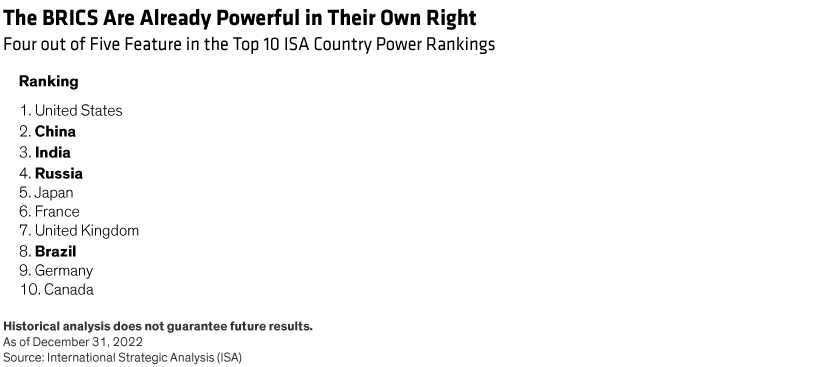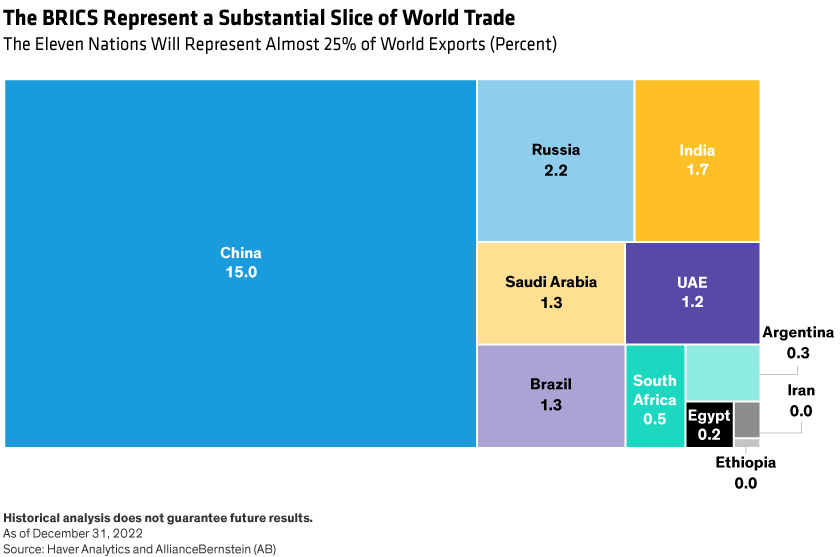The Chinese sage, Lao Tzu, taught that a journey of a thousand miles begins with a single step. The invitation for Argentina, Egypt, Ethiopia, Iran, Saudi Arabia and the UAE to become full members of BRICS may not transform emerging-market (EM) countries’ status immediately—but we believe it’s the first step on a significant journey.
The BRICS acronym was originally popularized to describe five prominent EM countries—Brazil, Russia, India, China and South Africa—with the potential to dominate the global economy by 2050. Today, BRICS denotes an organized group that seeks to further economic cooperation between its members and to advance their economic and political standing. The group is growing, becoming more heterogenous, and arguably getting more determined to reach the members’ individual goals through collaboration. Traditional thinking might characterize the expanded BRICS group as having limited common ground. But we think it’s risky to dismiss the potential shift in power arising from the group’s growth.
While the BRICS have divergent interests, they can still collaborate effectively to resolve their differences. A case in point was Vladimir Putin’s decision “by mutual agreement” not to attend the recent 15th BRICS summit. The objective was to avoid diplomatic embarrassment for the host country South Africa, given the International Criminal Court’s arrest warrant against the Russian president. In our view, this resolution reflects the BRICS’ general approach: cooperation and soft power.
Can the BRICS Achieve Their Goals?
So far, economic convergence with developed markets has been disappointing. Only China can point to discernible progress over the past decade, and even rapid Chinese growth rates have achieved only around 20% of US wealth levels, measured by GDP per capita.
But economic convergence isn’t the only BRICS objective. At the August summit, politics and security issues were described as the “backbone of cooperation” to achieve inclusive multilateralism. The BRICS’ real aim is no less than a “restructured global political, economic, and financial architecture that reflects the contemporary world and is more equitable, balanced and representative.” That will take time to achieve. But with the accession of the six new members on January 1, 2024, the group will be taking on a new dimension. And the summit’s directive to develop the BRICS partner-country model (and a list of prospective partner countries by the 2024 meeting) means further expansion is likely.
Meanwhile the BRICS are pressing their claims for a fairer world. At the summit, the group called for the review of International Monetary Fund (IMF) quotas to be finished by mid-December 2023 as planned, with a greater share of drawing rights to be allocated to EM. It also argued for EM representation among the leadership of the IMF and World Bank as part of a wider reform program of Bretton Woods institutions. We believe that these moves would make the institutions that are so deeply entwined with EM even more legitimate.
BRICS’ Hard and Soft Power
BRICS members already straddle multiple continental and regional organizations, including the United Nations, the G20, and the World Trade Organization. However, members sense that their individual and collective power remains below potential and doesn’t translate into equitable and balanced representation in global matters.
Wealth and military resources alone can’t define political power. There are many imperfect rankings of current political power, but most of them converge to approximate the rankings in the Display below. On this basis, the BRICS are already quite powerful. The new members of “BRICS Plus” (and potential future joiners) are generally ranked much lower, but the expanded group could be extremely powerful once it’s effectively organized.

The global balance of power has shifted over the past two decades as China’s impressive economic expansion pulled other EM countries with it. More recently, China’s economic growth impulse has been fading, but its size still gives it immense economic and military power.
As the BRICS attract more EM countries, the global balance of power will likely stay in a state of flux, though some current and future BRICS members could resist being pulled too far away from the West. So, while the group is growing, the BRICS might adopt a soft balancing policy to constrain Western power.
BRICS’ Trading Power
The new 11-nation bloc will be a formidable grouping of economic and trading power. The BRICS currently represent about 20% of world exports, with China accounting for 15%. The expanded BRICS would increase that share to almost 25%, on par with the euro area. Trade—particularly with China—could be a key benefit for other BRICS members, especially if it’s conducted more seamlessly through preferential trade agreements or a common currency.

The ambitious goal of a common currency seems unlikely to be achieved in the near future. However, BRICS finance ministers and central bank governors agreed at the recent summit to consider the issue of local currency payments and how that could contribute to greater stability, reliability and fairness in global financial transactions. And it appears that Brazil, China and Russia support searching for alternatives to the traditional (US dollar–based) financial architecture.
BRICS Are Paving a New Road
China’s Belt and Road Initiative (BRI) has expanded its reach and sway in global affairs over the past decade. But the BRI seems to be losing momentum as China’s economy slows, global financial conditions turn more challenging, and some partner countries reach—or even exceed—their debt limits. While the BRI might be losing some of its luster, the BRICS’ expansion could be another channel to rekindle EM dynamism over the medium term.
We don’t expect the new BRICS group to unlock significant EM economic growth opportunities in the short term. In fact, if the BRICS’ expansion is perceived as the Global South challenging the West, it could be counterproductive, with investors taking a more conservative stance toward EM. Ultimately, more power and broader representation will bolster the EM outlook, but the BRICS’ journey to achieve their goals is likely to be long and challenging.
The views expressed herein do not constitute research, investment advice or trade recommendations and do not necessarily represent the views of all AB portfolio-management teams. Views are subject to change over time .